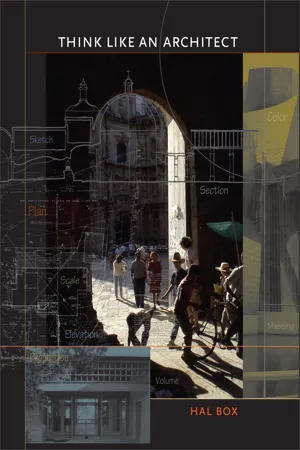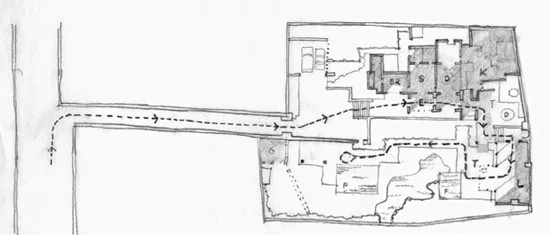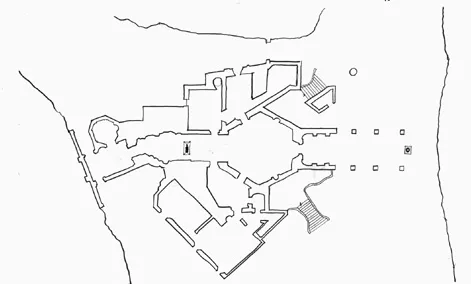![]() PART ONE: THE PLACE
PART ONE: THE PLACE![]()
CHAPTER ONE: ASPIRATIONS
That far land we dream about, Where every man is his own Architect.
ROBERT BROWNING (1812–1889)
Dear Martin:
When you told us in your drawing class that we had to visit a building to appreciate it, I didn’t realize that it is the actual experiencing of architecture that reveals, personally, in real time, the essence of the art. I learned that even beyond design, construction, intellectual content, and real estate value, your actual experience of the architecture is what affects your senses. And most important, your way of life—for better or worse. True, your quality of life is largely determined by how the art of architecture and city planning have made the physical place you inhabit. The benefits of gracefulness created by design can be priceless. I can’t relay to you the experience of a work of architecture in this letter, but I will describe examples of how I experienced the architecture of two special places.
Exploring central Mexico with a client in search of a site for a health spa, my wife and I were invited to see a house that might interest us because of its setting and its newly reduced price. At the end of a long day, we reluctantly turned off the main street and drove down a tree-lined drive paved with mosaic stones through an antique gate. It opened to reveal an extraordinary progression of architectural space made of carefully crafted indoor and outdoor spaces that melded the building in to, and out of, the landscape. Skillfully executed in the manner of the great Mexican modernist Luis Barragán, it was so successful that when one of the key architects of the last century, Charles Moore, walked through the house with an appraising eye, he looked back at the ethereal mass of landscape integrated with structured spaces and said, “Frank Lloyd Wright, eat your heart out.”
Only from the garden could you see the white stucco walls with large planes of glass dappled with light from mature flowering trees. Because the house was set in a tropical garden of green, with a sequence of fountains, ponds, and streams, it was hard to tell what was outside and what was inside. The transitions between spaces were so subtle and the openings so large that it seemed the house didn’t exist; the house denied being photographed. It was all transparency with a few walls modulating the space. The purity of style in Modernism was finessed with European antiques of various provenances in a manner that seemed just right. The architecture, garden, and interiors were by the noted Mexican interior designer Arturo Pani. It was the most beautiful house we had ever seen. It was not large but engaged us more deeply than the great historical houses—a magical place in the world that more than fulfilled every aspiration imaginable to us.
Transparency and ambiguity of landscape, structure, and glass. Casa Pani Cuernavaca, Mexico, 1986.
Spatial illusion from inside to outside. Casa Pani Cuernavaca, Mexico, 1986.
Plan of Casa Pani house and garden. Cuernavaca, Mexico, 1986.
Portion of the architectural accretion built over four hundred years. El Señor de Sacromonte, Amecameca, Mexico, 1524 onward.
On impulse, my real estate executive wife made a half-price offer to buy the house. The seller laughed at the offer, and we went away simply enjoying the deep feeling of having experienced a place of wonder. A month later, though, our offer was accepted, and a new life in a foreign country where we didn’t speak the language had just begun.
Compounding the experience of this timeless Mesoamerican Spanish-Mexican culture, we drove our new Mexican car over the Paso de Cortez between the two great volcanoes in search of the sixteenth-century churches of the Spanish friars. In the village of Amecameca, where Cortez had said a mass for his small army as they moved toward the Aztecs, we sought the pilgrimage chapel of Sacromonte by spiraling up a small hill overlooking the village. This sacred place had been a cave for meditation by Fray Martín de Valencia, who arrived in 1524 as one of the first friars in the New World. As the cave became important, the village built a portico to define the entrance, and over the next three centuries the cave was expanded by sacred spaces of advancing size, chronologically growing through several styles into a hexagonal dome terminating in an unusual nineteenth-century forecourt portico. We were fascinated with this unique assemblage of time and stone.
We bought a beer and a taco from a vendor in front of the church. The cold beer and warm blue corn taco filled with sautéed squash blossoms gave me a sensation that anchored me to this place. I identified with the architecture around me with such curiosity that within a few months I had formed a team of Earthwatch volunteers to document the church with measured drawings and photographs—the first of many such places in all parts of Mexico that we documented over the next twelve summers.
I had found a new way to appreciate architecture—from earthen caves to Modernism—in a continuum of ageless labors producing architecture that raised questions about what we architects are doing today.
Does all architecture have to be by architects? The nonarchitect friars of New Spain and the native Mesoamerican stonecarvers created a dramatically effective piece of work that borrowed from the buildings they knew and the materials and technology available to them at that particular place. The buildings of the nearby village were handsome indigenous buildings of distinctive forms and textures that had certainly been built by nonarchitects—put together out of the earth with adobe bricks formed by the same hands that patted out their tortillas. The vitality and dignity of those walls were timeless.
Realizing that the buildings in this village and most buildings in modern cities are built by nonarchitects, I became acutely aware of the plain fact that professional architects build only about 5 percent of what is built.
I had been aware of the fact of that 5 percent, but this scene, which I found so beautiful, caused me to realize that I had spent most of my career educating young men and women to be professional architects, signing hundreds of diplomas, and had not reached the men and women who would actually be designing 95 percent of the buildings. They were over in the schools of business and of engineering, or they were in all walks of life, people who simply built the facilities they needed. The reality of the other 95 percent was beginning to sink in.
To improve the built environment, the nonarchitects who are building now will have to know more about the making of architecture and actively aspire to it. In the past, before architecture schools and professional licensing, master builders received their training through apprenticeships in the crafts of building; they gained further learning from the examples of craftsmen before them, some of which were the great buildings of the age, made by builders who traveled across Europe to learn from the masters. Their building crafts were in stone, brick, and wood—earlier they had used mud and reeds, and later they used iron, glass, and early forms of concrete. Today, the designer’s vocabulary has a multitude of materials with which to work, including inexpensive, imitative, ersatz materials. Because of this, the task of the nonarchitect builder of today is more complex: new materials, a demand for speed and economy, and the lack of a good vernacular from which to work. So the difference between today’s builders and builders of the past is that in the past there were better models that were studied with more care and focus on the quality of the architecture. I believe that the commercial and residential nonarchitect builder, with an aspiration toward architecture and attention to detail, will be rewarded with an improved product for a better position in the market—an excellent motivation. This book can be a beginning of that process.
Town of Amecameca and mountain seen from under the sheltering portico. El Señor de Sacromonte, Amecameca, Mexico.
Section through cave, crypt, sanctuary, and portico. El Señor de Sacromonte, Amecameca, Mexico.
Plan, El Señor de Sacra-monte, Amecameca, Mexico.
The need to build shelter is primal; building it as architecture endures as a quest for beauty that engages us personally at our core. As I said in the preface, to make architecture rather than just a building, you have three choices: hire an architect, become an architect, or learn to think like an architect as an enthusiastic, informed participant in the design of the places we think of as architecture.
When I told my physics professor father, who at the moment was laying brick, that I had decided to become an architect, he looked up from his work and said, “Do you know the Greek orders, their columns: Doric, Ionic, Corinthian?” I said no and walked away to find the encyclopedia. At age fifteen, I had never even seen architecture or met an architect. I just liked to draw and make things. I never looked back, and architecture became my passion.
I was hardly alone. A recent survey of fifteen-year-old American boys revealed that fully 25 percent of them wanted to be architects when they grew up. People of all ages tell me that they had once wanted to be an architect but decided otherwise for various reasons.
In a television interview, James Lipton asked Michael Caine, who had just won an Oscar for Best Actor, what he would have done had he not gone into acting. Caine replied, “I would like to have been an architect.”
How do we account for this interest in architecture? Experiencing architecture gives us thrills—it stirs our emotions as only works of art can. We love to build things. We like to draw too. Lots of people delight in planning projects and visualizing ways to build them. We love to dream, to fantasize about designing and making things. We love to acquire things, to be artists, to put together complex organizations. There’s a curiosity about architecture—a desire to experience architecture, to anticipate it in an exotic setting, to understand it as a work of art, to keep it in our memory as a story, or to feel the thrill of making it ourselves. It’s a way of creating something from nothing, of bringing order to things in a satisfying way. It’s a way of helping people improve the way they live. It’s an art that rewards you and the community.
Should you want to, you can be a professional architect. The profession is indeed a thrilling one. You could be an active enthusiast—someone with a passion for beautiful architecture but no interest in designing it yourself. Or perhaps you could be an architecture scholar—someone who takes to architecture the way Civil War buffs take to that history—and maybe even extend that interest into doctoral studies.
The education of architects for the profession involved half of my career. It was a cause that I believed would make for better architecture and better cities. Yet, as I became an emeritus professor and at the same time moved to a 450-year-old mountain village in Mexico, I had a new look at the making of architecture.
My village, a solid mass of architecture-without-architects, gained its special architectural character from its many eighteenth-century religious and public buildings. The indigenous architecture built in local traditions supported a delightful lifestyle in a visually satisfying whole.
This was a different world. It became clear that I had been educating only a small fraction of the people who design buildings, because the fact is that nonarchitects, holding no professional degree or license, build almost all the buildings in the United States and probably everywhere else. The magnitude of this fact is rarely acknowledged, but nonarchitects are clearly the major force in the making of buildings and cities.
Street space formed by walls of residences and shops at the street edge in San Miguel de Allende, Mexico, 2000.
Houses set on a plane of grass with a street running through it. Residential street in United States.
Some nonarchitects excel at making architecture, while others seek the benefits of a better product to sell. They produce valuable products and come from many professions, particularly engineering. Those who aspire to make architecture rather than just building have the positive quality of the amateur. I use the word amateur in its original sense. The French word amare, meaning “to love,” is a root for the word amateur. The amateur, “one who loves an activity,” will be a focus of this book because to do architecture well you have to love it. Amateur is an enthusiastically positive term; it is not used pejoratively here. As I see it, the loving spirit of the amateur is essential to good architecture, irrespective of professional degrees or licensure.
Giving importance to this role of the amateur, Daniel Boorstin, the eminent historian, spoke eloquently on “the amateur spirit.” He said, “The rewards and refreshments of thought and the arts come from the courage to try something, all sorts of things, for the first time. An enamored amateur need not be a genius to stay out of ruts he has never been trained in. … In the long run, the ruts wear away, and adventuring amateurs reward us by a wonderful vagrancy into the unexpected.”
Helping nonarchitects learn about architecture obviously deserves our attention. In this book I hope to bring knowledge and confidence to discerning nonarchitects and to encourage them to take care to enhance the environment. Having worked with architects most of...









